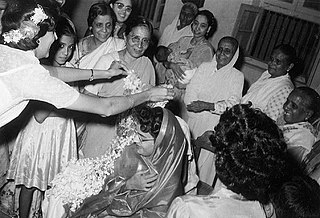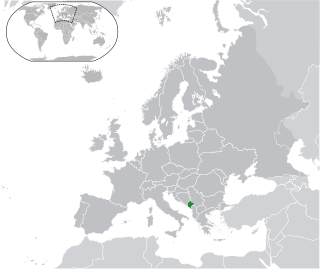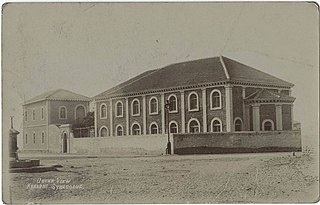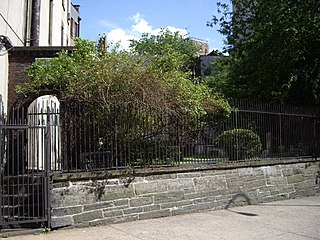Related Research Articles

The Mount of Olives or Mount Olivet is a mountain ridge in East Jerusalem, east of and adjacent to Jerusalem's Old City. It is named for the olive groves that once covered its slopes. The southern part of the mount was the Silwan necropolis, attributed to the elite of the ancient Kingdom of Judah. The western slopes of the mount, those facing Jerusalem, have been used as a Jewish cemetery for over 3,000 years and holds approximately 150,000 graves, making it central in the tradition of Jewish cemeteries. Atop the hill lies the Palestinian neighbourhood of At-Tur, a former village that is now part of East Jerusalem.

The Lublin Voivodeship, also known as the Lublin Province, is a voivodeship (province) of Poland, located in southeastern part of the country. It was created on January 1, 1999, out of the former Lublin, Chełm, Zamość, Biała Podlaska and (partially) Tarnobrzeg and Siedlce Voivodeships, pursuant to Polish local government reforms adopted in 1998. The region is named after its largest city and regional capital, Lublin, and its territory is made of four historical lands: the western part of the voivodeship, with Lublin itself, belongs to Lesser Poland, the eastern part of Lublin Area belongs to Red Ruthenia, and the northeast belongs to Polesie and Podlasie. Lublin Voivodeship borders Subcarpathian Voivodeship to the south, Świętokrzyskie Voivodeship to the south-west, Masovian Voivodeship to the west and north, Podlaskie Voivodeship along a short boundary to the north, Belarus and Ukraine to the east. The region's population as of 2019 was 2,112,216. It covers an area of 25,155 square kilometres (9,712 sq mi).
The history of the Jews in India dates back to antiquity. Judaism was one of the first foreign religions to arrive in the Indian subcontinent in recorded history. Desi Jews are a small religious minority who have lived in the region since ancient times. They were able to survive for centuries despite persecution and antisemitic inquisitions.

Gulshan-e-Iqbal is a large middle-class to upper middle class residential and commercial neighborhood in the Karachi East district of Karachi, Sindh, Pakistan. It was previously administered as part of the Gulshan Town borough, which was disbanded in 2011.
SherShah is a neighbourhood in Karachi, Pakistan, that is located along the northern bank of the Lyari River. Sher Shah is home to the Morroro Graveyard - a vast cemetery that is centuries old. It is also the site of some of Karachi's recycling industry. In October 2010, Baloch terrorists gunned down 13 members of the Urdu-speaking community in a spare-parts market.

The Chaukhandi tombs form an early Islamic cemetery situated 29 km (18 mi) east of Karachi, Sindh province of Pakistan. The tombs are notable for their elaborate sandstone carvings. The tombs are similar in style to the elaborate tombs at the Makli Necropolis near Thatta, and are built in the funerary architectural style typical of lower Sindh.

History of the Jews in Pakistan goes back to 1839 when Pakistan was part of British India. Various estimates suggest that there were about 1,000 to 2,500 Jews living in Karachi at the beginning of the 20th century, mostly comprising Iranian Jews and Bene Israel ; a substantial Jewish community lived in Rawalpindi, and a smaller community also lived in Peshawar.

The history of the Jews of Montenegro dates back to the times when that area was connected to the division of the Roman Empire between Roman and Byzantine rule. Since modern-day Montenegro is a young country the Jewish community of Montenegro is the youngest and one of the smallest Jewish communities in the world. The decision on forming a formal community was made in June 2011 at the home of Mrs. Đina Lazar in Herceg Novi. At the end of July of the same year, the community was registered as a citizens' association and thus gained certain legal legitimacy. Very soon after registering, the Chief Rabbi of Israel Rabbi Yona Metzger visited Montenegro and the Jewish community. Rabbi Metzger, along with escorts and leading members of the community, was received by the most important state officials: the Presidents of the State, the Parliament and the Government.

The Dzyatlava massacres were two consecutive mass shooting actions carried out three months apart during the Holocaust. The town of Zdzięcioł was located in the Nowogródek Voivodeship of the Second Polish Republic prior to World War II.

The Magain Shalome Synagogue was a synagogue in Karachi, Pakistan. It was built by Solomon David Umerdekar in 1893, when the region was still under British rule as India. The synagogue was destroyed in 1988 by the orders of then President of Pakistan, Muhammad Zia-ul-Haq, following which a shopping plaza was built in its place.

First Shearith Israel Graveyard, also known as Chatham Square Cemetery, is a tiny Jewish graveyard at 55-57 St. James Place in the Two Bridges neighborhood of Lower Manhattan, New York City. It is the oldest of three Manhattan graveyards currently maintained by Congregation Shearith Israel, which is itself the oldest Jewish congregation in North America. Today, the cemetery is a mere fragment of its original extent. Only about a hundred headstones and above ground tombs can still be seen in what remains of the old burial ground, which rises slightly above street level. It is the only remaining 17th century structure in Manhattan.

Kaufering was a system of eleven subcamps of the Dachau concentration camp which operated between 18 June 1944 and 27 April 1945 and which were located around the towns of Landsberg am Lech and Kaufering in Bavaria.

The Gora Qabaristan, or Gora Cemetery, literally transliterated as White (man's) graveyard is Karachi, Pakistan's only operational Christian cemetery.
Antisemitism in Pakistan is the presence of hostility and discrimination against Jews in Pakistan based on prejudices against the Jewish people and/or the religion of Judaism. Alongside the prevalence of general stereotypes, Jews are commonly subjected to negative views, feelings and rhetoric in Pakistan, most of which overlap with and are directly related to the antisemitic views prevalent throughout the Islamic world. Widely regarded as miserly within Pakistani Muslim circles, Jews residing in Pakistan have also faced periodic intolerance by the state, which has intensified since the Islamization period of the 1980s under Muhammad Zia-ul-Haq, who propelled Pakistan towards the adoption of strict and highly-conservative Islamic practices and laws. The Jewish population of Pakistan has rapidly decreased since the state's founding and separation from neighbouring India in August 1947, and as of 2019 estimates, stands at less than 200 people amidst Pakistan's total population of over 200 million, the majority of whom are Muslims.

Nahalat Yitzhak Cemetery is a Jewish municipal burial ground in the Tel Aviv District city of Givatayim, Israel, east of the Nahalat Yitzhak neighborhood of Tel Aviv. Founded in 1932, it includes more than 30,000 graves, including those of Israeli political and cultural figures, and Rebbes of several Hasidic dynasties. The cemetery contains several tracts of military graves and mass graves of unidentified soldiers from the period of the 1948 Arab-Israeli War. It also features memorials to Jewish communities destroyed in the Holocaust.
Pechora was a concentration camp operated by Romania during World War II in the village of Pechora, now in Ukraine. The concentration camp was established on the gated grounds of what had once been a private estate of the Polish noble Potocki family on the banks of the Southern Bug river, which had been converted into a sanatorium for tuberculosis patients after the Russian revolution.
Israeli forces damaged or destroyed at least 16 cemeteries in the Gaza Strip during the 2023 Israel–Hamas war in various places in Gaza, as determined by evidence gathered by CNN, the New York Times and Euro-Med Human Rights Monitor.
References
- ↑ "Karachi: Bene Israel graveyard: buried in time or conscience?". dawn.com. 2007-05-06. Retrieved 2019-09-22.
- 1 2 Karachi's Jewish cemetery in dire need of repair 13 March 2011. Retrieved 22 May 2011
- ↑ "In search of the Jews of Karachi". Express Tribune . 6 February 2011. Retrieved 13 November 2011.
- ↑ Balouch, Akhtar (Sep 16, 2015). "Karachi's 'Yahoodi Masjid'". Dawn newspaper . Retrieved 26 December 2016.